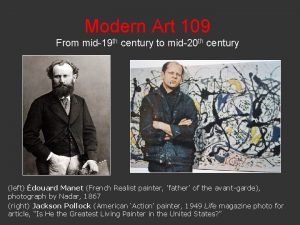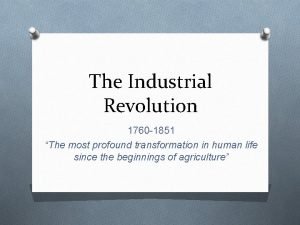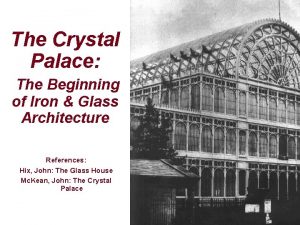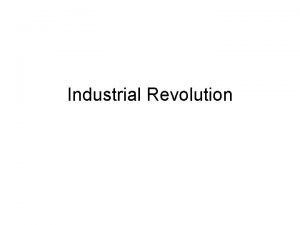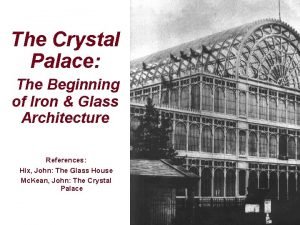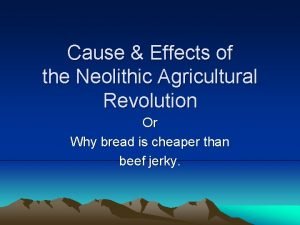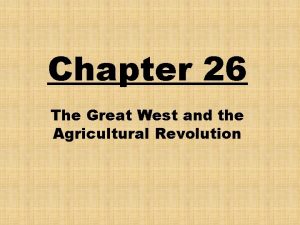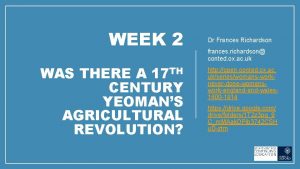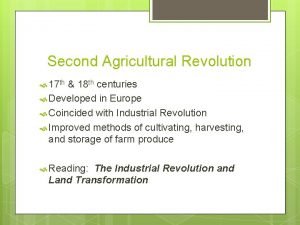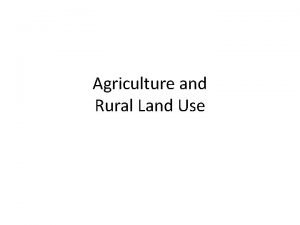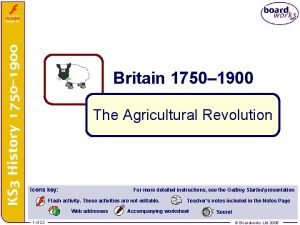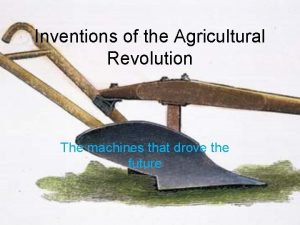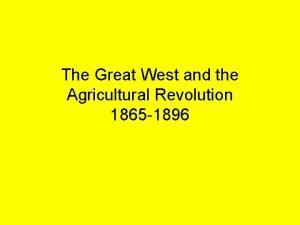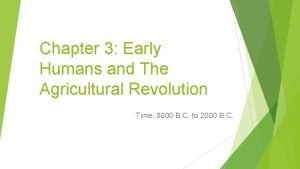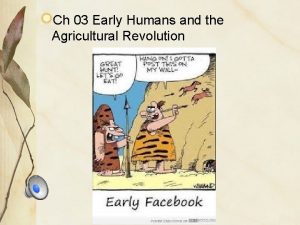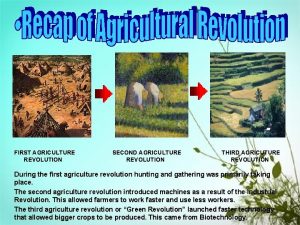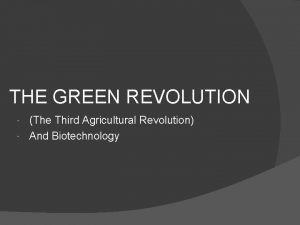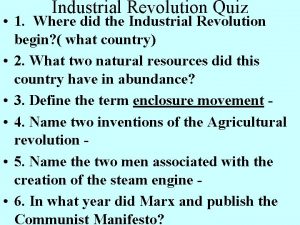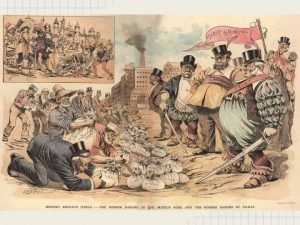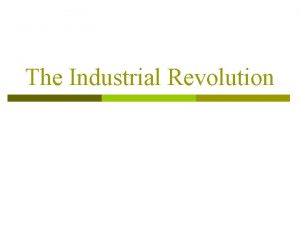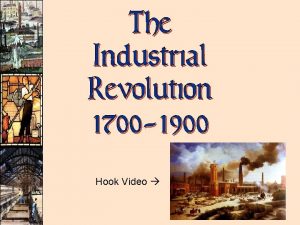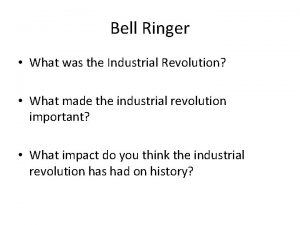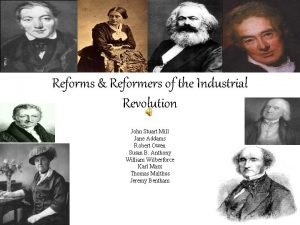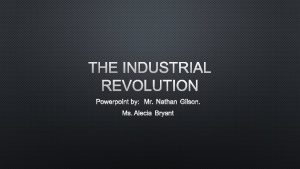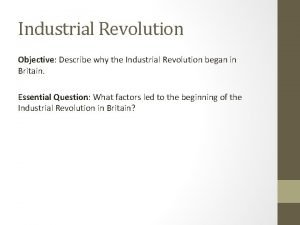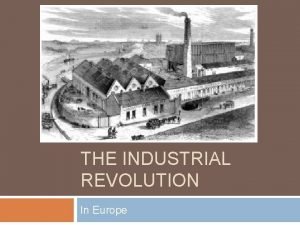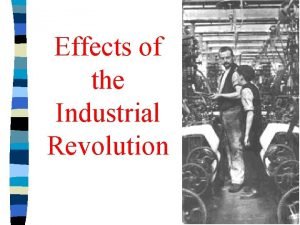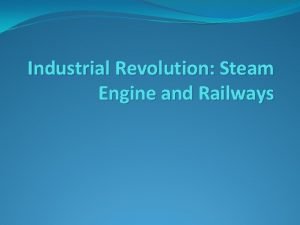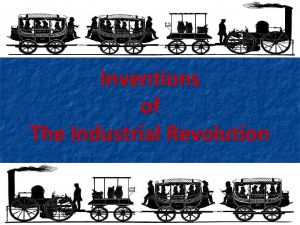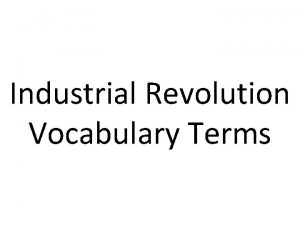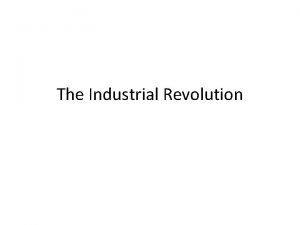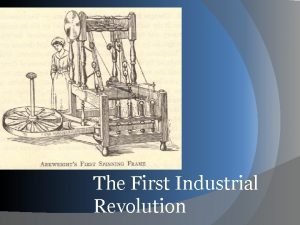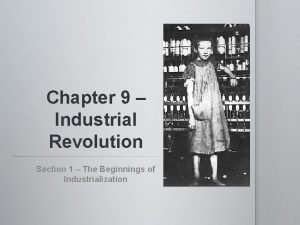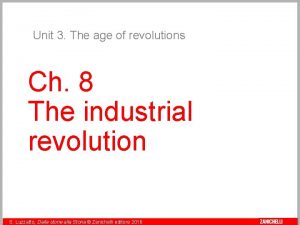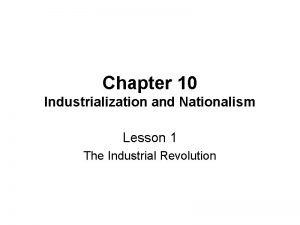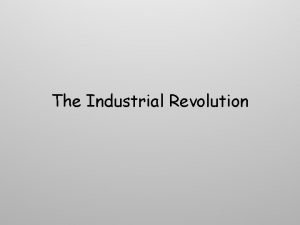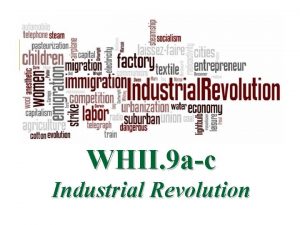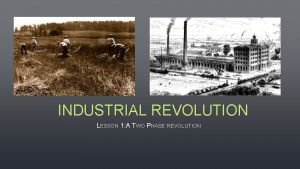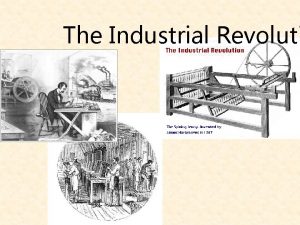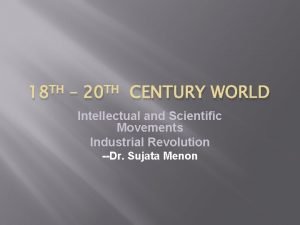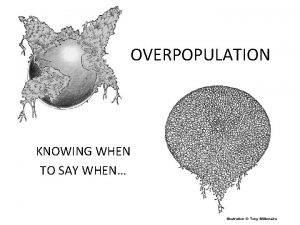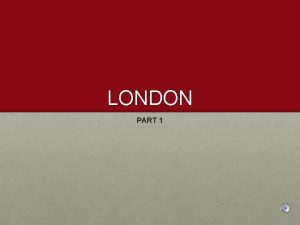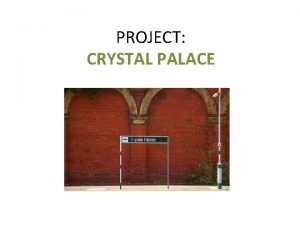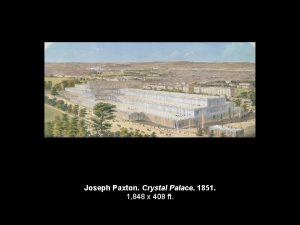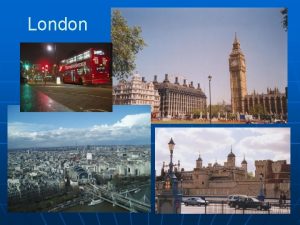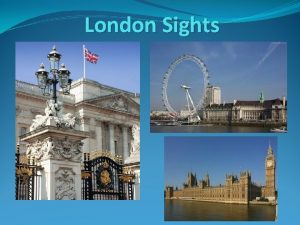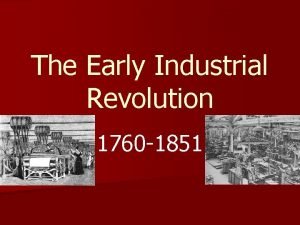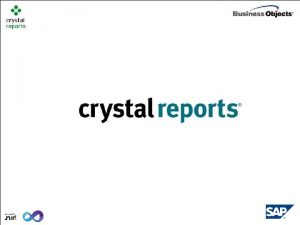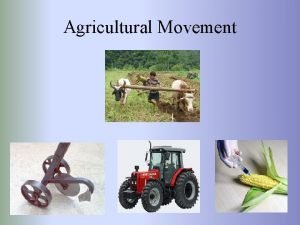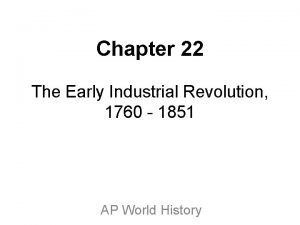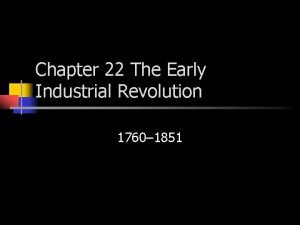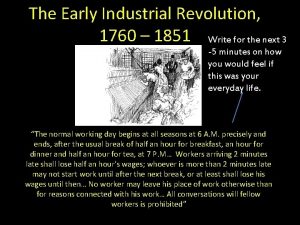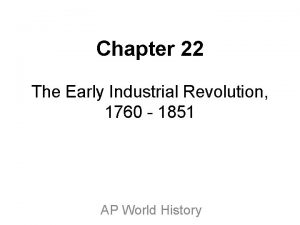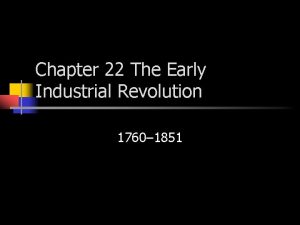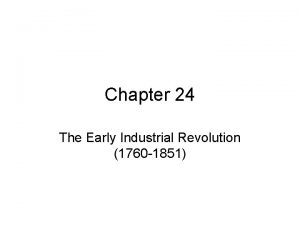Industrial Revolution Crystal Palace London 1851 The Agricultural






















































- Slides: 54

Industrial Revolution Crystal Palace, London 1851

The Agricultural Revolution

Agricultural Innovations and Innovators A. Started in Low Countries (Netherlands) – population and land pressures B. Jethro Tull (1674 -1741) 1. Experimented and financed experiments 2. Use iron plows and plant with drills (instead of casting) 3. Permitted longer growing season

More on agriculture… C. Charles “Turnip” Townshend (1674 -1738) and crop rotation 1. Before – leave land fallow (unused) every few years 2. Now - Use fallow land to grow a crop that restores nutrients and feeds livestock 3. Root crops (clover, potatoes, and turnips) put nitrogen back in the soil 4. Effects – more food, food in winter, larger animals

Crop Rotation

Robert Bakewell and animal husbandry: …increased the size and weight

1. Enclosure movement in England 1. 2. 3. 4. 5. Before – villages collectively farmed lands – each farmer had several unconnected lots and shared common space Enclosure – consolidate all land to use land more rationally and make a greater profit Used acts by Parliament to seize common land Effects – increased productivity, caused riots, disrupted life in the countryside Significance – introduced entrepreneurial spirit in countryside

Jean Francois Millet – “The Gleaners”

The First Industrial Revolution

I. Putting-out system / Protoindustrialization A. Manufacturers provided raw materials to workers in cottages B. Workers either spun or wove C. Manufacturer moved goods from cottage to cottage then sold the finished product D. Limits on production capacity – led to failure to meet demand E. Begins in England


Inventions A. Slowly changed the industry B. Flying shuttle (1733) – John Kay… sped up the carding and weaving process

A. Spinning jenny (1764) - James Hargreaves …. increased the number of thread spindles a worker could use

A. Water frame (1769) - Richard Arkwright… made the first spinning mill (took textile manufacture out of the home)

Power loom 1780’s: Edmund Cartwright

A. Steam engine (1769) 1. James Watt improved the Newcomen steam engine used in mines 2. Provided independent source of power (not near moving water)

Iron production increased

Transportation Revolution A. Railways – first developed in coal mines, but steam engine transformed railways B. Richard Trevithick – made the first steam -powered locomotive on an industrial rail line

A. George Stephenson 1. Built the engine for the Rocket which went from Liverpool to Manchester at 16 miles per hour

Stephenson’s rocket

Locomotives began to speed up to 50 mph… 1840 – 2000 miles of track 1850 – 5000 miles of track

Effects of railroads 1. 2. 3. 4. 5. Increased production in coal and iron industries Created middle class investors because railroad construction needed capital New job opportunities Economy – reduced the prices of goods, created larger markets; increased sales meant more factories and machinery; the profits enabled entrepreneurs to reinvest their money Psychological – power over nature

Issues of the Industrial Revolution

Expansion of the Industrial Revolution Great Britain led world until mid 19 th century o Why did it happen in Britain? n o o o Politically united Common language No internal tariffs Wealthiest nation in the world Colonies provided raw materials

#1 continued…. o o o Developed banking and credit People accepted paper money Improved roads and extensive water transportation (canals) Stable that protected private property Entrepreneurial spirit

Continental Europe slow to catch up… n Problems: n Suspicion of paper money, n Difficult to obtain credit and raise capital n Government debasing currencies n Few nobles interested in manufacturing

n n n Fewer roads and less entrepreneurial spirit Political disruption – FR, Napoleon Agricultural focus Britain prevented artisans and machinery from leaving First caught Belgium, France, German states, United States

The Factory System Ended putting out system and workers no longer own the ‘means of production’ – tools and equipment are owned by manufacturer Demanded discipline l l Machines needed to run full time to take advantage of investment Workers work regular hours in shifts to achieve maximum output Challenge to people’s routines l l Fines for misbehavior for adults and beatings for children

1. Dreadful working conditions Hours: 12 -16 hrs per day, six days per week, ½ hour for lunch and supper No job security, no minimum wage Conditions harsh and dangerous in cotton mills, coal mines Children and women employed in cotton mills and mines – l l l Factories and mines as orphanages Women paid half of men’s wages


Government reforms on child labor Factory Acts between 1802 -1809 n n Limited labor for children between 9 and 16 years to 12 hours per day No employment of children under 9; Instruction in reading and arithmetic during working hours in cotton mills

2. Factory Act of 1833 a. Children between 9 and 13 could work only 8 hours per day b. 13 -18 only 12 hours per day c. Factory inspectors d. Children between 9 and 13 required to receive at least two hours of elementary instruction 3. 1842 – Coal Mines Act – eliminated the employment of boys under ten and women in mines 4. 1847 – Ten Hours Act – reduced the workday for children between 13 and 18 to ten hours

1. Consequence - more women to work in factories 2. Whole families worked A. Social and political reform movements 1. Chartists, Utopian Socialists, Marxists

The Social Impact and the Growth of Cities Population Growth 1750 – 140 million; 1800 – 187 million; 1850 – 266 million Heavy industrialization in some areas and overpopulation in countryside n n o Irish Potato famine

The Growth of Cities a. Cities were centers for manufacturing, industry, and government b. Made possible by steam engine, cheap labor, and transportation c. Britain – had most large cities in Europe – London over 2, 363, 000 in 1850

Miserable living conditions a. Wealthy and middle class lived on outskirts – workers lived in center of city b. Overcrowded, unsanitary, unhealthy c. The Poor Law Commission in England in the 1820’s investigated living conditions – saw prostitution, crime, sexual immorality


Urban Reformers a. Urban situation was a danger to society b. Edwin Chadwick – Report on the Condition of the Labouring Population of Great Britain i. Urged the elimination of unsanitary conditions with sewers and drainage ii. Led to the Public Health Act of 1848 in England

The second industrial revolution… 1850 -1900 Steel… Chemicals… Electricity…

a global economy…

STEAM REVOLUTIONIZED TRANSPORTATION… Late 1800’s were golden age of railroads 1850: 23, 600 miles of track 1880: 228, 400 miles of track By 1875, “iron horse” on every continent except Antarctica Boosted trade and industry


STEAMSHIPS

BREAKTHROUGHS IN TRANSPORTATION…Promontory Point, Utah May 10, 1869



The Telegraph § Invented by Samuel F. B. Morse in 1840’s § 1850: all major cities in eastern U. S. connected by telegraph lines § 1851: telegraph cable connected London to Paris under English Channel § 1866: 1 st transatlantic cable linked Newfound land Ireland § 1875: communication around the world in 5 minutes

Telegraph cable works, Greenwich , England 1857

How did people find the money to expand the size of businesses? ? n CORPORATIONS n n n Sold shares of stock Many different owners Stockholders could make money two ways Limited liability Investment banks specialized in raising capital world wide Often became monopolies CREATION OF A GLOBAL ECONOMY

THE DEMOGRAPHIC CONSEQUENCES: EMIGRATION AND IMMIGRATION 1850: 266 million people lived in Europe n 1900: 400 million population n Between 1850 and 1900: 25 million left Europe for other places n Rural residents flocked to European cities n

Demands for Reform o The Utopians o The Socialists o Marx and Engels o Unions

Robert Owen and New Lanark

socialism Government central planning to bring about reform State ownership of key industries Result → greater economic equality ←Charles Fourier

KARL MARX February 1848: published the Communist Manifesto Bourgeoisie: factory-owning middle class Proletariat: the working class Economic forces dominated society Consequences felt in the 20 th century… Lenin Mao Ho Chi Minh Fidel Castro
 The crystal palace 1851
The crystal palace 1851 Third agricultural revolution
Third agricultural revolution 1851
1851 Crystal palace glass house
Crystal palace glass house Crystal palace design
Crystal palace design Crystal palace
Crystal palace Crystal palace
Crystal palace First agricultural revolution ap human geography
First agricultural revolution ap human geography Neolithic revolution causes and effects
Neolithic revolution causes and effects Chapter 26 the great west and the agricultural revolution
Chapter 26 the great west and the agricultural revolution The agricultural revolution
The agricultural revolution The second agricultural revolution coincided with
The second agricultural revolution coincided with The second agricultural revolution
The second agricultural revolution Agricultural revolution worksheet
Agricultural revolution worksheet Agricultural revolution inventions
Agricultural revolution inventions The great west and the agricultural revolution
The great west and the agricultural revolution Early humans and the agricultural revolution
Early humans and the agricultural revolution Early humans and the agricultural revolution answer key
Early humans and the agricultural revolution answer key First agricultural revolution
First agricultural revolution Chapter 3 lesson 2 the agricultural revolution
Chapter 3 lesson 2 the agricultural revolution The third agricultural revolution
The third agricultural revolution Industrial road london ontario
Industrial road london ontario Russian revolution vs french revolution
Russian revolution vs french revolution Could the french revolution have been avoided
Could the french revolution have been avoided Quiz 1: early development of industry
Quiz 1: early development of industry Skyscraper vocabulary
Skyscraper vocabulary Manchester in the industrial revolution
Manchester in the industrial revolution Industrial revolution hook
Industrial revolution hook 2nd industrial revolution timeline
2nd industrial revolution timeline Industrial revolution bell ringer
Industrial revolution bell ringer Putting-out system
Putting-out system Reformers in the industrial revolution
Reformers in the industrial revolution Nathan gilson
Nathan gilson Objective of industrial revolution
Objective of industrial revolution When did the industrial revolution start
When did the industrial revolution start Famous people of the industrial revolution
Famous people of the industrial revolution 3 effects of industrial revolution
3 effects of industrial revolution Beam engine application
Beam engine application Phonograph industrial revolution
Phonograph industrial revolution Industrial revolution vocabulary
Industrial revolution vocabulary Industrial revolution def
Industrial revolution def Water frame significance
Water frame significance The tyger industrial revolution
The tyger industrial revolution Introduction on industrial revolution
Introduction on industrial revolution Chapter 9 the industrial revolution
Chapter 9 the industrial revolution An age of revolutions zanichelli
An age of revolutions zanichelli Industrialization and nationalism lesson 4
Industrialization and nationalism lesson 4 Flying shuttle john kay
Flying shuttle john kay Edward jenner
Edward jenner The industrial revolution lesson 1
The industrial revolution lesson 1 4th industrial revolution
4th industrial revolution Enclosure industrial revolution
Enclosure industrial revolution Phonograph industrial revolution description
Phonograph industrial revolution description Thomas malthus overpopulation
Thomas malthus overpopulation Syncretism definition ap human geography example
Syncretism definition ap human geography example
